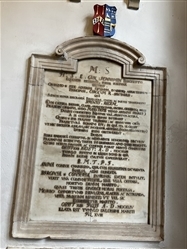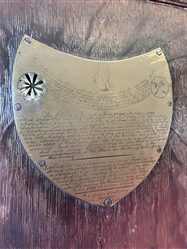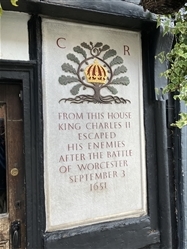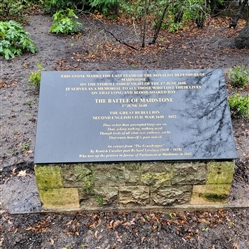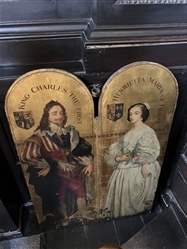Pennyman, Sir William 1607-1643
Title:
Knight
Military Rank:
Colonel
First Name:
William
Last Name:
Pennyman
Memorial Type:
Memorial - Funerary
Does the monument still exist?
Yes
Installation Date:
1644 onwards
Inscription:
M. S./ H. S. E. Gulielmus Penniman Baronettus Equestri dignitate parique animo decorus, obsequio & fide adversus optimum, eundemque af∣flictissimum Principem Carolum Regem spectabilis, qui serinissimum Regem (cum caetera Inermis classe, Armamentariis arcibus, omnibus belli praesidiis orbatus, nudo majestatis titulo armatus staret) duabus cohortibus Equitum una. Peditum altera, a se conscriptis primus in∣struxit; quibus & ipse praefuit tribunus, ac brevi Vrbis Oxon. prae∣fectura donatus est in qua it a se gessit, ut nec discessor Ashlaeus, nec successor Astonus magna bello nomina) luminibus ipsius obstruerat. Demum Febre Epidemica correptus in medio aetatis honorumque decur∣su premature extinctus, triste sui desiderium apud omnes reliquit, qui∣bus morum suavitate ac comitate fuerat merito charissimus. Obiit Aug. 22. A. D. 1643. tumulo potitus in eadem domo in qua ingenii cultum capessaverat
Quoted in David Lloyd, The Memoires of the lives, actions, sufferings & deaths of those noble, reverend and excellent personages that suffered by death, sequestration, decimation, or otherwise, for the Protestant religion and the great principle thereof, allegiance to their soveraigne, in our late intestine wars, from the year 1637 to the year 1660, and from thence continued to 1666 with the life and martyrdom of King Charles I, (London: 1668), pp.643-. (see http://quod.lib.umich.edu/e/eebo/A48790.0001.001/1:124?rgn=div1;view=fulltext)
Translated into English as
"Here is buried William Pennyman, Baronet, distinguished for his knightly rank, and fortune just as exalted, outstanding for his obedience and loyalty to the best and also most cruelly treated of princes, King Charles. Who, when of late the abominable rebellion began, immediately joined the Royalist party and, when his most serene king was otherwise unarmed, robbed of fleet, weaponry, fortresses and every warlike protection, and armed only with the bare title of royalty, was the first to raise by his own efforts, and equip him with two companies, one of cavalry, and the other of infantry, which he also commanded in person; and not long after was given the command of the garrison of Oxford. In this task he performed so well that neither his predecessor Ashley nor his successor Ashton (both men of warlike renown) could obscure his brilliance. At last, carried off by the plague fever in the prime of his life and distinctions, he died a premature death, leaving sadness and a sense of loss in the hearts of all by whom, because of his charm and friendliness, he had been deservedly held most dear. He died on the 22nd of August 1643, winning a tomb in the same House as that wherein he had first begun his education. He lies buried in this tomb who had deserved so well."
From: http://glosters.tripod.com/offzdiedp.htm
His wife, Anne (nee Atherton), b.c. 1609, died 13 July 1644 and is buried with him and remembered on his memorial.
Allegiance:
Royalist
Condition:
Very Good
Condition Description:
Personal observation
Memorial Notes:
Pennyman served the King as Colonel of Yorkshire Trained Band Regiment of Foot in the Bishops' Wars (1639-40) and in the early months of the Civil War, joining the King at Nottingham for the raising of the standard. His regiment of foot and troop of horse were represented at the Battles of Powick Bridge, Edgehill and Marlborough, his foot becoming part of the Oxford garrison and main field army and his horse part of Prince Rupert's Horse and April - August 1643 he was Governor of Oxford until his death 22 August 1643. His regiment was taken over by his cousin, Sir James Pennyman of Ormesby Hall, North Yorkshire.
For the life of Pennyman see: Philo, Phil 2022 “Outstanding for his obedience and loyalty to the best and also most cruelly treated of princes” : Sir William Pennyman (1607-1643) of Marske and his Regiments of Foot & Horse, in Arquebusier (Journal of the Pike & Shot Society) Vol.XXXVII, VI, May 2022
Memorial Address:
Christ Church Cathedral, St Aldate's, Oxford OX1 1DP
County:
Oxfordshire
Country:
England
Location within building:
South transept, Christ Church Choir
Geoloation:
SP 51554 05971


